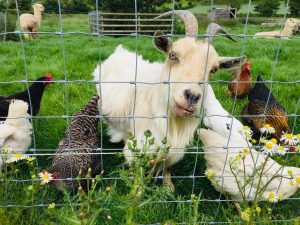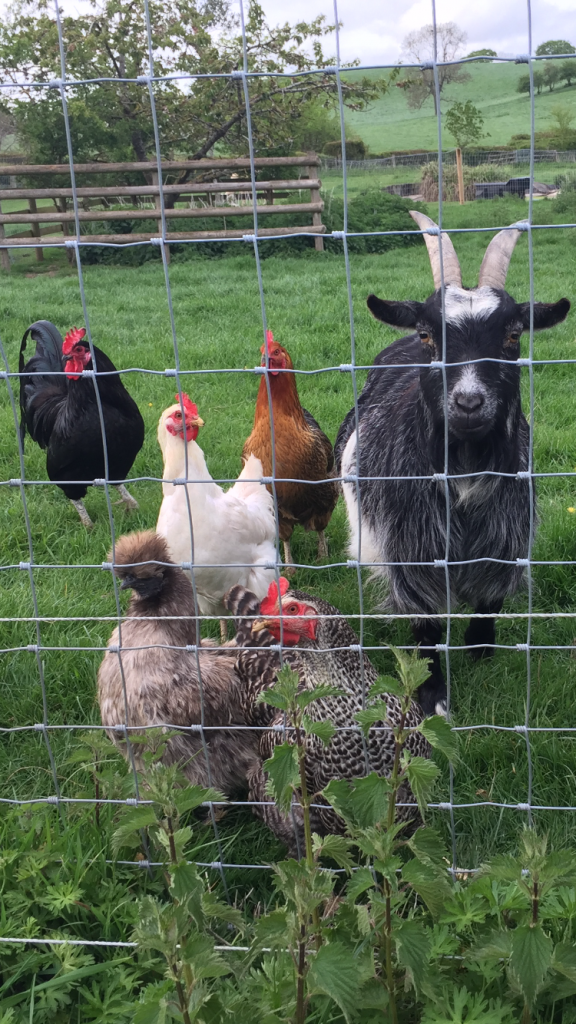In the last 8 years we have owned several goats and fenced around 2500ft and this is my guide to fencing goats. In this review we will cover
- Posts & wire styles
- Electric fencing for goats
- Why fixed knot, no climb wire is far superior.
I’m not here to sell you on anything, just give my feedback….as goats are the Harry Houdini, escape artists of the animal world! Remember it is KEEPING goats IN but ALSO keeping predators OUT! Think of it as a two way system.
There are 3 main styles of post and rail fences:
- Split Rail
- Corral Board (also called ‘Kentucky Board’) and
- Post and Dowel (also known as Western Rail)
But, I’m afraid to tell you, none of the above are good for goats! Yes you want the post but then you are going to need a post and wire fence.
Yes this is more expensive but I’ve actually heard from a few realtors that adding great fencing onto a property will give it value add. So you should consider it as an investment, but in honesty it’s not that expensive….

The posts (remember no more than 8-10ft apart for goats and sheep) are straight forward but the key is in the wire.
It’s sooo much better than the welded wire fences as goats love to place their hooves on the fence. With a simple welded wire fence the strand will simply break. Because they are not tied together, just welded, the welds because they are only small just break. Do not use this fence for goats; it won’t last even a season.
Often called field wire, hogg wire or net wiring. The beauty then, of this type of ‘no climb’ ‘fixed knot wire’ is
- When they jump up they wont be able to break it
- You don’t need to keep it electrified, saving power, hassle and worry.
- Maintenance free, as it’s not hot, so you don’t need to cut/mow/spray/trim the grass beneath it, saving time.
- Doesn’t fold, sag or bow down.
- Galvanized so it won’t rust and will be amazingly weather resistant.
- Reusable – if you want to extend anything or remove a section just roll it back and store in the barn for later use. Easily get 30+ years use from it.
- Hybrid use – so you can also use this in conjunction with a hot wire running along the top of bottom. Top to prevent anything jumping over and bottom to prevent anything digging under. Although, and this may seem a bit belt and braces, I dig this type of the fence in a little bit at the bottom into the ground to ensure nothing will dig under. Just a few inches will deter anything. Really versatile if you plan to have, like we have, goats, sheep, alpaca, ducks and chickens all in the same field.
Best brands include KEYSTONE and BEKAERT Corp

Electric Fence for Goats
1. Electric Netting Fencing
Let’s start with probably the most popular which is electric or electrified netting. This is often quoted as being a temporary solution but under the right circumstances it can be used effectively for years.
This is the best you can buy in my opinion and ships the next day from Amazon as a complete kit.
Let’s run through the pros and cons:
Pro’s: relatively cheap to purchase vs buying and setting big heavy corner fence post for a welded/woven wire fence. It’s also great if you plan to move the goats every few days or week to a new area so they can graze the grass.
This system of farming, moving goats for fresh grass, is as old mother earth herself and ensures fresh and healthy goats usually without the need for feed.
Lets run though the cons though…. as they stack up
Con’s: ALOT more maintenance than other fencing types. Firstly, you will have to mow or strim a strip underneath wherever you want to run this electric net fence to stop grass or weeds from growing up and earthing it out. Because without a shock the goats will run a riot with this fence.
Secondly, it must be ‘on’ all the time. It must have charge and power and be able to provide a shock otherwise a few things happen, which are the start of the downfall of these fences.
Firstly they start to stick their heads through and feed on the grass on the other side of the net. That saying the grass is always greener couldn’t be more true!
Once they have their head through, and no shock was given, there is a high chance that they will have their head stuck. Make no mistake this can be fatal and people have lots of animals due to this issue.
Secondly, if their head gets stuck they will pull the fence down trying to free themselves. I’ve seen this happen. Of course you know what happens next…all your other goats wonder over the ‘downed’ fence and escape. So you have one goat with their head trapped and the rest of your goats out wondering!
The electric netting fences are recommended for: people wishing to provide a safe place for just a few goats, where post fencing wouldn’t be cost effective and for people who want to move the fence so that they can manage the grazing on new grass.
It also should be for anyone comfortable with doing some DIY prep to ensure cut grass on the bottom wouldn’t ‘short out’ the fence and you are sure it will have sufficient power to keep it hot.
2. Electrified High Tensile Fencing
I use just 5 strands and I’ve never had any issue with escaping goats OR predators. ‘They’ actually recommend around 6-8 and so I guess there is no right or wrong answer here, just what you are comfortable with buying and can get the best sleep with, knowing your goats are safe.
Let’s run through the wire strands and their heights:
5th or ‘top strand’ is 10 inches above the lower one. Roughly 36 inches off the ground. It’s up to you whether you run this hot or not. If you plan to step over this wire to get in once or several times a day it’s probably easier to leave it off. However if you have predators which will prefer to jump rather than dig or crawl under, such as foxes or coyotes, then electrify this top strand.
4th strand up from the bottom I’ve put 8 inches above the 3rd strand ie 26 inches off ground. You will notice this is slightly different to the others (@6 inches) but this down to the size of my goats, you can tailor this to your exact needs. Or just keep it uniformed at 6 inches from each other. It’s just about being right, not what looks ‘cool’ or what someone told you to do. I run this strand hot too.
3rd strand up from the bottom is electrified and sits 6 inches up from the strand below it ie 18 inches off the ground.
2nd strand up from the bottom sits 6 inches off the bottom stand i.e. roughly 12 inches off the ground. This strand is grounded meaning if anything tries to get through it, it will create a current through them.
Bottom wire strand roughly 6 inches off the ground. This means nothing can crawl under, either a predator in or a goat crawling out! It also means i’ve got plenty of room to mow under the bottom strand to stop the grass growing up too high. Very very important to always have an electrified bottom strand, for obvious reasons.
Benefits of this type of electric fencing for goats is that it’s very easy to install and relatively cheap too. I’ve placed in good sized corner wooden fence posts and cemented them in too with this set up as I’m thinking for the long term, which added to the cost a little but you don’t need to do that.
It makes for a great psychological barrier more than an actual physical barrier, such a pen made of pallets. But if anything touches it once they will stay away from it forever. So people find this to be a very effective method for predator control.
The lines have really good spring tension too, which makes this a great fence. If, for example, a tree branch falls on it, you can cut the branch off and it will spring right back. No sagging!
Disadvantages of this electric goat fence is they are still fairly high maintenance. You will have to mow or cut the grass under the bottom strand to ensure it works effectively. Being only 6 inches off the ground it’s really easy for grass or weeds to grow up around it.
I don’t like to spray any weed killer under it, I know that is the easy method because the goats would ingest it and it could make them sick. Mine are actually all organic!
I would recommend buying and installing good quality corner posts for this method and burying them deep (with bracing) This adds to the costs BUT will add to the effectiveness and longevity of this type of electrified goat fence.
Can I add this into an existing fence?
Yes you can. It’s very versatile, if you already have a fence and want to add a couple of strands of hot wire into it then this is the perfect option.
I used this method when we needed to move sheep and goats into a field which had previously been used for cattle.

First up I simply ran a hot wire 6 inches off the floor as a bottom strand. I left the barbed wire strand next up from the bottom, but added another hot tensile wire strand as the 3rd up from the bottom. Worked like a dream. Really simple and cost effective.
Best Sheep and Goat Fence
Goats and sheep get on well, so its a good idea to save space and run them in the same paddock. If you plan to keep sheep and goats in the same field and require a good quality robust fence then this is the one you want.
The fixed knot woven wire fence will keep all sheep and all goats in the field and predators out! You cannot use the cheaper welded wire fencing as the sheep will headbutt straight through it in seconds, if the goats haven’t already hooved it to pieces!

